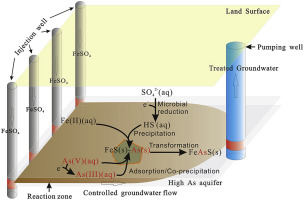Remediation of arsenic-contaminated groundwater by in-situ stimulating biogenic precipitation of iron sulfides
Pi, Kunfu;Wang, Yanxin*; Xie, Xianjun; Ma, Teng; Liu, Yaqing; Su, Chunli; Zhu, Yapeng; Wang, Zhiqiang
WATER RESEARCH,Volume 109, 1 February 2017, Pages 337–346
DOI: 10.1016/j.watres.2016.10.056
ABSTRACT:

Severe health problems due to elevated arsenic (As) in groundwater have made it urgent to develop cost-effective technologies for As removal. This field experimental study tested the feasibility of in-situ As immobilization via As incorporation into newly formed biogenic Fe(II) sulfides in a typical As-affected strongly reducing aquifer at the central part of Datong Basin, China. After periodic supply of FeSO4into the aquifer for 25 d to stimulate microbial sulfate reduction, dissolved sulfide concentrations increased during the experiment, but the supplied Fe(II) reacted quickly with sulfide to form Fe(II)-sulfides existing majorly as mackinawite as well as a small amount of pyrite-like minerals in sediments, thereby restricting sulfide build-up in groundwater. After the completion of field experiment, groundwater As concentration decreased from an initial average value of 593 μg/L to 159 μg/L, with an overall As removal rate of 73%, and it further declined to 136 μg/L adding the removal rate up to 77% in 30 d after the experiment. The arsenite/Astotalratio gradually increased over time, making arsenite to be the predominant species in groundwater residual As. The good correlations between dissolved Fe(II), sulfide and As concentrations, the increased abundance of As in newly-formed Fe sulfides as well as the reactive-transport modeling results all indicate that As could have been adsorbed onto and co-precipitated with Fe(II)-sulfide coatings once microbial sulfate reduction was stimulated after FeSO4supply. Under the strongly reducing conditions, sulfide may facilitate arsenate reduction into arsenite and promote As incorporation into pyrite or arsenopyrite. Therefore, the major mechanisms for the in-situ As-contaminated groundwater remediation can be As surface-adsorption on and co-precipitation with Fe(II) sulfides produced during the experimental period. 全文链接